
Sighthounds (also called gazehounds) are a type of hound dog that hunts primarily by sight and speed, unlike scent hounds, which rely on scent and endurance.

Sighthounds (also called gazehounds) are a type of hound dog that hunts primarily by sight and speed, unlike scent hounds, which rely on scent and endurance.

These dogs specialize in pursuing prey, keeping it in sight, and overpowering it by their great speed and agility. They must be able to detect motion quickly, so they have keen vision. Sighthounds must be able to capture fast, agile prey, such as deer and hares, so they have a very flexible back and long legs for a long stride, a deep chest to support an unusually (compared to other dogs) large heart, very efficient lungs for both anaerobic and aerobic sprints, and a lean, wiry body to keep their weight at a minimum. Sighthounds have unique anatomical and physiological features, likely due to intentional selection for hunting by speed and sight; laboratory studies have established reference intervals for hematology and serum biochemical profiles in sighthounds, some of which are shared by all sighthounds and some of which may be unique to one breed. [1]
The typical sighthound type has a light, lean head, which is dolichocephalic in proportion. This shape can create the illusion that their heads are longer than usual. Wolves and other wild dogs are dolichocephalic or mesaticephalic, but some domestic dogs have become brachycephalic (short-headed) due to artificial selection by humans over the course of 12,000 years. [2] Dolichocephalic dogs have a wider field of vision but smaller overlap between the eyes and therefore possibly poorer depth perception in some of their field of view than brachycephalic dogs; most, if not all, dogs have less visual acuity than their antecedent, the wolf. [3] There is no science-based evidence to confirm the popular belief that sighthounds have a higher visual acuity than other types of dogs. However, there is increasing evidence that dolichocephalic dogs, thanks to a higher number of retinal ganglion cells in their "visual streak", retain more heightened sensitivity than other dog types to objects and rapid movement in the horizontal field of vision. [4]
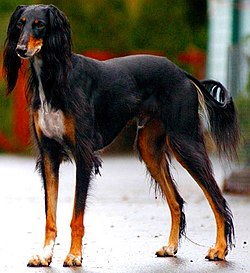
Sighthounds such as the Saluki/Sloughi type (both named after the Seleucid Empire) may have existed for at least 5,000 years, with the earliest presumed sighthound remains of a male with a shoulder height around 54 cm, comparable to a Saluki, appearing in the excavations of Tell Brak dated approximately 4,000 years before present. [5] The earliest complete European description of a sighthound and its work, the Celtic vertragus [6] from Roman Spain of the 2nd century C.E., comes from Arrian's Cynegeticus . A similar type, possibly a moderately sized male sighthound, with a height of 61–63 cm, of approximately the same historic period, the Warmington Roman dog is described from a well-preserved skeleton found in England. [7] Sighthound type "gracile" bones, dating from the 8th to 9th century CE, anatomically defined as those of a 70 cm (28 in) high "greyhound", were genetically compared with the modern Greyhound and other sighthounds and found to be almost identical with the modern Greyhound breed, with the exception of only four deletions and one substitution in the DNA sequences, which were interpreted as differences probably arising from 11 centuries of breeding of this type of sighthound. [8] [9] Population genomic analysis proposes that true sighthounds originated independently from native dogs and were comprehensively admixed among breeds, supporting the multiple origins hypothesis of sighthounds. [10] [11]
Although today most sighthounds are kept primarily as pets, some of them may have been bred for as many as thousands of years to detect movement of prey, then chase, capture, and kill it primarily by speed. They thrive on physical activity. Some have mellow personalities, others are watchful or even hostile towards strangers, but the instinct to chase running animals remains strong. [12]
Apart from coursing and hunting, various dog sports are practiced with purebred sighthounds, and sometimes with lurchers and longdogs. Such sports include racing, lure coursing, and other events.
| Name | Origin | Recognition | Other Names | Image |
|---|---|---|---|---|
| Afghan Hound | Afghanistan | FCI, AKC |  | |
| Azawakh | Mali | FCI |  | |
| Borzoi | Russia | FCI, AKC | 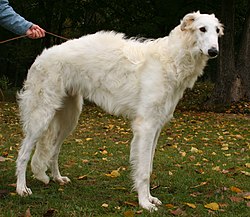 | |
| Chart Polski | Poland | Polish Greyhound |  | |
| Chippiparai | India | KCI |  | |
| Chortai | Russia |  | ||
| Cirneco dell'Etna | Italy |  | ||
| Deerhound | Scotland | FCI, AKC |  | |
| Galgo Español | Spain | FCI |  | |
| Greyhound | England | FCI, AKC |  | |
| Irish Wolfhound | Ireland | FCI, AKC |  | |
| Italian Greyhound | Italy | FCI, AKC | Piccolo Levriero Italiano |  |
| Kaikadi | India | |||
| Kanni | India | KCI |  | |
| Kazakh Tazy | Kazakhstan |  | ||
| Kritikos Lagonikos | Greece | Cretan Hound |  | |
| Levriero Sardo | Italy | |||
| Magyar Agár | Hungary | FCI |  | |
| Mudhol Hound | India | KCI |  | |
| Old Croatian Sighthound † | Croatia / Bosnia-Herzegovina | |||
| Patagonian Greyhound [13] | Argentina | Galgo Barbucho Patagónico | ||
| Pharaoh Hound | Malta | FCI, AKC | 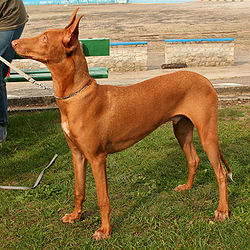 | |
| Rampur Greyhound | India | 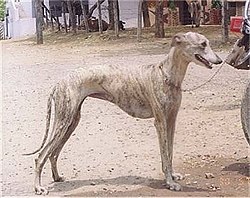 | ||
| Saluki | Middle East | FCI, AKC |  | |
| Sarail Hound [14] | Bangladesh | |||
| Silken Windhound | USA |  | ||
| Sloughi | North Africa | FCI | Arabian Greyhound |  |
| Taigan | Kyrgyzstan | VDH |  | |
| Whippet | England | FCI, AKC |  | |
| Xigou | China | CKU | Xian Hound, Shanxi Xigou, Xiquan, Xiliegou, Xiǎn |
| Name | Origin | Breeds Used | Image |
|---|---|---|---|
| American Staghound | USA | Greyhound, Scottish Deerhound, Irish Wolfhound, Borzoi, Saluki, Whippet |  |
| Kangaroo hound | Australia | Greyhound, Scottish Deerhound, Irish Wolfhound, Borzoi, Saluki |  |
| Longdog | Mix between sighthounds |  | |
| Lurcher | Sighthound + herding dog or terrier | 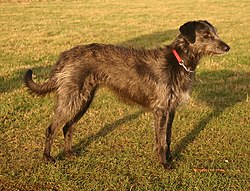 |
A number of breeds or types of dogs which do not hunt solely by speed and sight, as well as a number of non-hunting breeds, are currently being recognized as sighthounds, either formally or informally [15] by kennel clubs, or lure and live coursing clubs. These include:
When competing in conformation shows, most Anglophone kennel clubs, including the American Kennel Club and The Kennel Club (UK), group pedigree sighthound breeds together with scent hounds in a Hound Group, [16] [17] the Fédération Cynologique Internationale groups them in a dedicated Sighthound Group, [18] whilst the United Kennel Club groups them in a Sighthound and Pariah Group. [19]